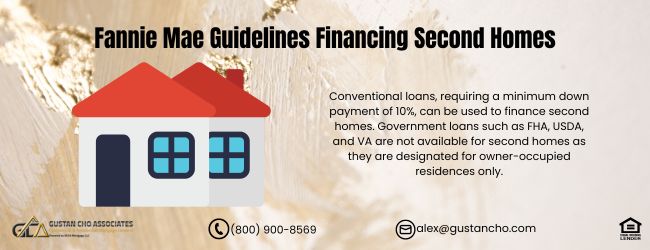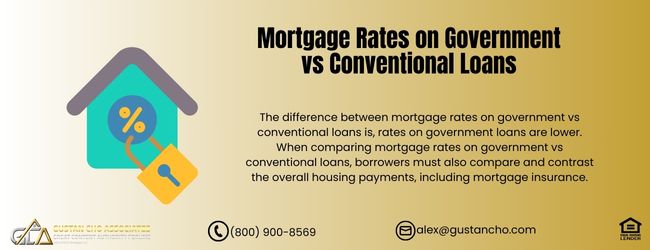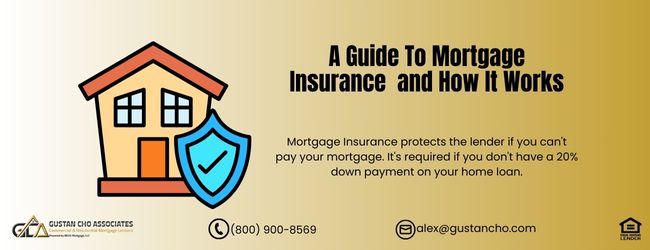Fannie Mae Guidelines Financing Second Homes

This guide covers financing second homes and investment properties. We will discuss financing second homes. A good percentage of homeowners own second homes or vacation homes. Financing second homes can be done with conventional loans and require 10% down payment. FHA, USDA, VA loans are for owner-occupied mortgage loans only.
Fannie Mae provides specific guidelines for financing second homes, which can be an appealing option for those looking to purchase vacation properties or investment opportunities.
Second-home loans are not allowed with government loans. Mortgage Rates on second homes are very competitive. Actually, second home mortgage rates are similar to mortgage rates on primary home financing. FHA insured loans do not qualify for second homes. FHA insured homes are for owner-occupied residential homes only. There are certain mortgage restrictions in second home loans. In the following paragraphs, we will cover the key points from Fannie Mae’s guidelines financing second homes.
Eligibility Requirements Financing Second Homes
The property must be occupied by the borrower for some portion of the year and must be suitable for year-round occupancy. The property must be a one-unit dwelling. Typically, the second home should be located a reasonable distance away from the borrower’s primary residence, often defined as at least 50 miles. The borrower must have exclusive control over the property and it cannot be subject to any rental agreements, timeshares, or other similar arrangements during periods when the borrower is not occupying the property.
Financial Requirements Financing Second Homes
Fannie Mae and Freddie Mac guidelines financing second homes require a minimum down payment of 10% is usually required for second homes. A good credit score is necessary, often with a minimum required score around 620 or higher, depending on the lender’s specific requirements. The DTI ratio requirements must be met, typically not exceeding 45%, but this can vary depending on other financial factors and the lender’s criteria. Borrowers must have sufficient reserves, typically covering at least two to six months of mortgage payments for both the primary residence and the second home.
Second Home Property Requirements
The second home must not be a rental property or a timeshare arrangement. The property cannot be subject to any management agreements that require the borrower to rent it out. The property must be suitable for year-round use and cannot be a seasonal residence only. The borrower must have full control over the property without any restrictions on its use.
Loan Limits and Types
Loan Limits: Conforming loan limits apply, but high-balance loans might be available in certain high-cost areas. Various loan products are available, including fixed-rate mortgages and adjustable-rate mortgages (ARMs).
Speak With Our Loan Officer for Mortgage Loans
Documentation Financing Second Homes
Borrowers must provide full income documentation to verify their ability to make mortgage payments on both the primary and second homes. Proof of reserves and down payment funds is required. A full appraisal is necessary to determine the property’s market value. Financing a second home through Fannie Mae involves meeting specific eligibility criteria, financial requirements, and property standards. These guidelines ensure that the borrower can comfortably manage the additional financial responsibility of a second home. For more detailed information and updates, you can refer to Fannie Mae’s official guidelines and consult with mortgage lenders to understand the specific requirements and options available.
Mortgage Guidelines Financing Second Homes
Homeowners who own a principal home and want to purchase a second home, there are two types of mortgage loan programs. One is financing for second homes. The other type of financing program is financing for an investment home. The main reason borrowers want second homes financing versus investment homes financing is that the mortgage rates on second homes financing is lower than investment homes. Down payment requirements for second homes is 10% down payment versus the 20% down payment for investment home financing.
To qualify for second home mortgage rates, most lenders need to be convinced that it is a second home purchase and not investment property.
The mortgage loan underwriter wants to see some distance between a primary residence and second home. They usually want to see a 60-mile distance from primary home and second home. The second home is in a different state, that would even be better to convince the mortgage underwriter. Other factors include whether the second home is a waterfront property. Or whether it is in a tourist area like near Disney World in Orlando, Florida. If second homes are waterfront properties or are in tourist areas like Orlando, Florida, then the 100 miles away distance is normally waived. Speak With Our Loan Officer for Mortgage Loans
Underwriters Letter of Explanation on Financing Second Homes
I get many calls from potential mortgage loan borrowers who are interested in purchasing second homes for various reasons. Some want a second home so they can be closer to their kids and grand kids. Others want a second home because they want to be closer to their jobs. Mortgage underwriters may want a letter of explanation if the second home is a similar property as the owner occupied home:. Also if the distance of the second home is close by the primary home. Homebuyers shopping for second or investment homes who have questions, please contact us at 1-800-900-8569 or text us for a faster response. Or email us at gcho@gustancho.com.
FAQs: Fannie Mae Guidelines Financing Second Homes
- What are the main options for financing second homes? Conventional loans, requiring a minimum down payment of 10%, can be used to finance second homes. Government loans such as FHA, USDA, and VA are not available for second homes as they are designated for owner-occupied residences only.
- What are the key requirements for a second home loan under Fannie Mae guidelines? The borrower must occupy the property for some period during the year. It must be appropriate for occupancy throughout the year. The property should also be located at least 50 miles from the borrower’s primary residence. The borrower must also have exclusive control over the property, with no rental agreements or timeshare arrangements in place.
- What financial criteria must be met to finance a second home? A minimum down payment of 10% is required, and a good credit score, typically 620 or higher, is necessary. The debt-to-income ratio (DTI) generally should not exceed 45%, although this can vary. Additionally, borrowers must have sufficient reserves, usually covering two to six months of mortgage payments for both homes.
- Are there specific property requirements for a second home? Yes, the property must not be a rental or timeshare property, should not be under any management agreements requiring rental, must be suitable for year-round use, and must be under the borrower’s full control without restrictions.
- What are the loan limits and types available for second home financing? Conforming loan limits apply, with the possibility of high-balance loans in high-cost areas. Various loan products, including fixed and adjustable-rate mortgages (ARMs), are available.
- What documentation is required to finance a second home? Borrowers must supply full income documentation, proof of reserves, and down payment funds and obtain a full appraisal to determine the property’s market value.
- How do second-home mortgage rates compare to primary-home mortgage rates? Second-home mortgage rates are very competitive and similar to primary home financing.
- Why might a mortgage underwriter require a letter of explanation? A letter of explanation may be needed when the second home is similar to the primary residence or is close to the primary residence. It’s important to clarify and explain the reason for purchasing the second home.
- How does the distance between the primary and second home affect the loan process? Underwriters generally prefer a distance of at least 60 miles between the primary residence and the second home. This requirement may be waived if the second home is a waterfront property or in a tourist area.
- How can I get more information or apply for a second home mortgage? For more detailed information and updates, refer to Fannie Mae’s official guidelines. You can also consult with mortgage lenders to understand the specific requirements and options available. For questions, contact us at 800-900-8569, text us for a faster response, or email gcho@gustancho.com.







Responses